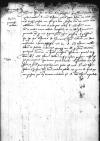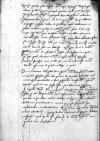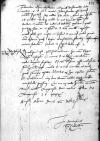Quibus verbis Dominationi Vestrae Reverendissimae gratias agere debeam, cum mente hoc vix concipere possim, non est opis meae, frustra etiam cum inertia mea colluctarer, tot enim et tanta sunt eiusdem Dominationis Vestrae Reverendissimae in me iam a multis annis collata beneficia, ut ne illa quidem enumerare, quomodo igitur pro eis dignas gratias agere possem et potissimum hoc tempore, quo reverendissimus dominus ⌊Ioannes episcopus Culmensis⌋, cui Deus misereatur, e vivis cessit, ubi tum Dominatio Vestra Reverendissima nullum laborem et studium intermisit, quousque me illi per gratiam serenissimorum ⌊principum⌋ nostrorum in episcopatu successorem efficeret. Quantum itaque Dominationi Vestrae Reverendissimae debeam et quam praestare possum, mihi ipsi sat sum conscius. Hoc tamen, quod unicum in facultate mea est, facio et gratias, quas exiguitas mea potis est eniti, Dominationi Vestrae Reverendissimae habeo, Christum dominum nostrum oraturus sedulo, ut pro me id, quod ego non possum, cum omnium bonorum retributor est, Dominationi Vestrae Reverendissimae rependat.
Quae hic aguntur, satis diffuse ⌊maiestati regiae⌋ ⌊⌋. Nescio quid iterum quidam Germani principes, quorum capita sunt ⌊marchio Ioachimus Brandenburgensis⌋ et ⌊Georgius dux Mysschnensis⌋, moliantur. Induxerunt bonum ⌊caesarem⌋, ut ⌊terras⌋, quas
illustris
⌊dux Albertus⌋ in ⌊Prussia⌋ possidet, ⌊Valtero de Cronenberg⌋ magistro in ⌊Alemania⌋ in feudum concederet, quod prius nullus imperatorum fecit. Licet mihi ⌊caesar⌋ responderit hanc concessionem nihil iuris addere, ubi prius ius nullum fuit, tamen cum prius numquam talis actus celebratus sit in ⌊imperio⌋, hoc tempore etiam, quo maxime Christianorum animorum concordiae intendi convenit, fieri non debuisse, cumque ego ea in re nullum speciale mandatum et instructionem habeam, aliud facere non potui, quam hoc, quod abundius in ⌊⌋ ad ⌊regiam
maiestatem⌋ descripsi. Unde si fortassis a me erratum est, non immerito mihi veniam dandam. Feci enim id, quod intellexi et potui.
De re Luterana lice{n}t quidam bene sperent, nihil boni futurum video. In articulis praepositis fuit inter primos de annatis tollendis vel in eos usus convertendis, in quos per ⌊concilium⌋ Constantiense[1] fuerant deputatae, quod cum non posset fieri sine
detrimento Romanae curiae, per legatum reverendissimum dominum ⌊Campeium⌋ admitti non potest. Consenserat quidem, quod certi abusus ecclesiae vel reformarentur vel tollerentur penitus et hoc clare voluit intellegi in his, in quibus emolumentis ⌊Sedis⌋ non praeiudicaretur, veritus, quod si quid istiusmodi hic constitueretur et admitteretur, id per totum orbem Christianum veniret admittendum. Hisque diebus ⌊Lutheranis⌋ ad proposita dabitur responsum, quod quale est futurum, Dominationem Vestram Reverendissimam cum primis non latebit.
⌊Florentini⌋ adhuc obsidentur, ad quos destruendos totis viribus ⌊sanctissimus dominus noster⌋ incumbit; intus feruntur esse bonorum militum stipendiariorum sex milia praeter cives, foris qui obsident 16 milia, resque nulla vi aut tormentis agitur, sed ducitur in moram, ut inedia ad deditionem cogantur, quod priusquam fiat, ne in potestatem sanctissimi domini nostri veniant, expulsa inutili plebe, quae misere in hostium et amicorum oculis perit, omnia extrema pati digni commiseratione Florentini obfirmatis animis statuerunt. Scilicet is superis labor est.
Quod reliquum est, cum sciam volumen hoc meum ⌊regiae maiestati⌋ inscriptum in manus Dominationis Vestrae Reverendissimae venturum, nolui longiori scriptione Dominationi Vestrae Reverendissimae esse molestior. Quam humiliter rogo, velis et remis incumbat, ut tandem, quod summopere desidero, liberatus ex hoc exilio salvam et incolumem iam tum demum videre et reverenter complecti possim. Cui me ex corde humiliter commendo.


